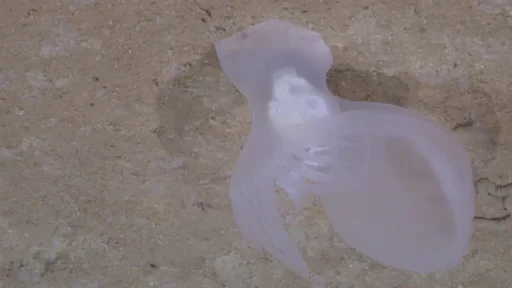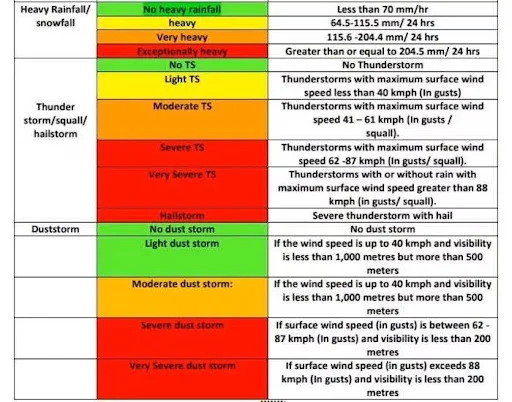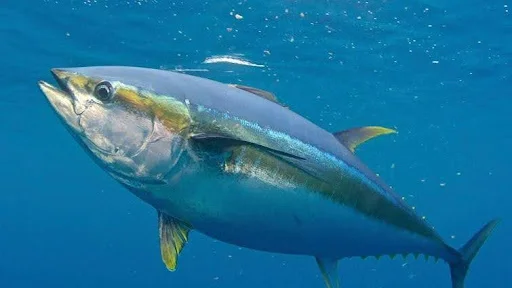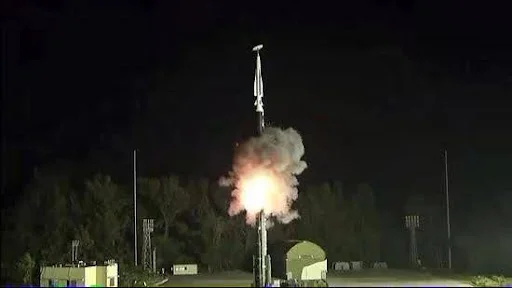UPSC GS 1
Midnight Zone
- News: A team of researchers has recently identified a glowing marine creature named Bathydevius caudactylus, a newly discovered species of mollusk, within the ocean’s midnight zone.
- About the Midnight Zone: The ocean water column is divided into five zones:
- Sunlight zone (epipelagic).
- Twilight zone (mesopelagic).
- Midnight zone (bathypelagic).
- Abyssal zone (abyssopelagic).
- Hadal zone (trenches).
- As light penetrates water, it is rapidly absorbed, with red, orange, and yellow wavelengths disappearing first. Blue light persists but vanishes completely by a depth of around 1,000 meters (approximately 3,300 feet).
- The midnight zone, or bathypelagic zone, begins at 1,000 meters and extends to 4,000 meters (around 13,100 feet), reaching the seafloor in many regions.
- It represents the largest habitat on Earth, comprising 70% of all seawater.
- This zone is characterized by:
- Perpetual darkness.
- Steady temperatures of approximately 4°C (39°F).
- Hydrostatic pressure ranging from 100 to 400 atmospheres, depending on depth.
- Organisms living in this zone have evolved unique adaptations, including:
- Highly developed visual and auditory systems.
- Bioluminescence, which is used for attracting mates or luring prey.
- The ability to withstand extreme cold and pressure.
- Key Facts About Bathydevius caudactylus:
- Discovery: This glowing species is a newly identified mollusk found in the midnight zone.

- Unique Characteristics:
- Classified as a sea slug, the apple-sized creature displays features unlike any known sea slug.
- It glows through bioluminescence and is equipped with a paddle-like tail and a large, gelatinous hood.
- It is the first sea slug discovered to inhabit the deep ocean.
- Discovery: This glowing species is a newly identified mollusk found in the midnight zone.
- Habitat and Movement:
- Unlike most sea slugs that live in coastal areas, tide pools, or on the seafloor, Bathydevius caudactylus thrives in the deep ocean.
- It moves vertically through the water column by flexing its body or drifting with currents.
- Reproductive Features: The species is hermaphroditic, meaning it possesses both male and female reproductive organs.
Read also: Accessibility for Persons with Disabilities in India | UPSC
Guru Nanak Jayanti/ Gurpurab
- News: PM Narendra Modi greeted people on Guru Nanak Jayanti and wished that his teachings inspire people to further the spirit of compassion, kindness and humility.
- Definition: Guru Nanak Jayanti commemorates the birth of Guru Nanak Dev Ji, the first Sikh Guru and the founder of Sikhism.

- About Guru Nanak Dev Ji:
- Birthplace: Guru Nanak Dev Ji was born in Talwandi, which is now known as Nankana Sahib in Pakistan.
- Era: He lived in the 15th century and was a contemporary of Mughal Emperor Babur.
- Sacred Teachings: His teachings are preserved in the Guru Granth Sahib, the holy scripture of Sikhism.
- Kartarpur Establishment: He established a spiritual center at Kartarpur (now Dera Baba Nanak) on the banks of the Ravi River.
- Vision of Liberation: Guru Nanak believed liberation was not a state of passive bliss but an active life dedicated to social responsibility and community service.
- Succession: Before his passing, he appointed Bhai Lehna as his successor, who became known as Guru Angad Dev Ji. Guru Angad later compiled Guru Nanak’s compositions.
- Major Teachings of Guru Nanak Dev Ji:
- ‘Ik Onkar’ (One God): He taught that there is one God who resides in all His creations and represents the eternal truth.
- Truthfulness: He emphasized living truthfully, declaring truth as the highest virtue in life.
- Social Equality: Guru Nanak condemned social inequality and criticized the caste system, advocating for equal rights for all.
- Religion: He urged people to refrain from using religion for material gain and emphasized its spiritual essence.
- Relevance of Guru Nanak’s Teachings in Modern Times:
- Equality and Brotherhood: His teachings on equality can address issues like gender and caste discrimination, as well as conflicts and wars across the globe.
- Vaand Chhako (Share What You Have): Encouraging sharing and generosity can help bridge the gap between the rich and the poor.
- Kirat Karo (Earn Honestly): His emphasis on earning through honest and ethical means can reduce corruption in society.
- Sarbat da Bhala (Welfare of All): His message of universal welfare is crucial for tackling climate change and promoting environmental justice.
Willingdon Island
- News: Rejuvenation of Willingdon Island, once a bustling hub for port-related activities, has taken centre stage in discussions at trade union forums, with calls for concrete measures to restart its commercial operations.
- Location and Scenic Beauty: Willingdon Island is one of the most picturesque spots in the Kochi region of Kerala.
- Man-Made Structure: It is an artificial island named after Lord Willingdon, who served as the British Viceroy of India. The island is considered one of the largest man-made islands in India.
- Key Institutions: Willingdon Island is home to important establishments such as the Kochi Naval Base of the Indian Navy, the Central Institute of Fisheries Technology, and the Port of Kochi.
- Connectivity: The island is connected to the mainland through the Venduruthy Bridge.
- Who was Lord Willingdon (1931–1936)?
- Position: Lord Willingdon was the 22nd Viceroy and Governor-General of India, serving between 1931 and 1936.

- Key Events During His Tenure:
- Government of India Act, 1935: This act was a significant legislative reform that introduced provincial autonomy and expanded the role of Indians in governance.
- Second Round Table Conference (1931): Mahatma Gandhi represented the Indian National Congress at this conference, where discussions on constitutional reforms took place.
- Communal Award (1932): Introduced by British Prime Minister Ramsay MacDonald, it aimed to allocate separate electorates for minorities and backward communities in India.
- Poona Pact (1932): This was an agreement between Mahatma Gandhi and Dr. B.R. Ambedkar to provide fair representation for the depressed classes while avoiding separate electorates.
- Third Round Table Conference (1932): The Third Round Table Conference ended in failure as neither Gandhi nor the Indian National Congress participated in it.
UPSC GS 2
Tsunami Ready Recognition Programme
- News: Twenty-four coastal villages in Odisha were recognised by the Intergovernmental Oceanographic Commission of UNESCO as ‘Tsunami Ready’.
- About the Tsunami Ready Recognition Programme: This is an international, community-driven recognition initiative developed by the Intergovernmental Oceanographic Commission (IOC) of UNESCO.
- Aim: The programme focuses on creating resilient communities by promoting awareness and preparedness measures to safeguard lives, livelihoods, and properties from tsunami threats worldwide.

- Objective:
- Enhance the readiness of coastal communities to handle tsunamis.
- Reduce potential losses by fostering collaborative efforts to achieve a standardized level of preparedness.
- Process for Recognition:
- Communities must fulfill a set of 12 established indicators across three categories: Assessment, Preparedness, and Response.
- Successful communities receive the “Tsunami Ready” recognition by UNESCO/IOC, which is valid for four years and requires periodic renewal.
- Implementation:
- This voluntary, performance-based program encourages partnerships among national and local emergency management and warning agencies, government bodies, scientists, community leaders, and the general public to ensure an active readiness framework.
- What is a Tsunami?
-
- Tsunamis are massive waves generated by abrupt movements of the ocean floor, typically triggered by underwater earthquakes.
- Characteristics:
- A tsunami consists of a series of long waves caused by significant ocean displacement, often resulting from seismic activity near or beneath the ocean floor.
- These waves radiate outward in all directions from their origin, capable of traveling across entire ocean basins.
UPSC GS 3
IMD Colour Codes
- News: Delhi AQI has hit 500 in several parts of Capital, the IMD has issued a yellow alert for dense fog conditions.
- Why are colour codes used?
- The India Meteorological Department (IMD) issues colour-coded weather warnings to alert the public about severe or hazardous weather conditions.
- These warnings aim to prepare people in advance for potential damage, disruptions, or risks to life caused by adverse weather.
- Key Features:
- Warnings are reviewed and updated on a daily basis.
- These alerts are universal and may also be issued during floods, based on rising water levels caused by heavy rainfall.

- Colour Codes Used by IMD:
- Green (All is Well): No advisory is issued under this category. It indicates that the weather is stable and poses no threat.
- Yellow (Be Aware): Indicates potentially severe weather conditions lasting for several days. Suggests that the weather could worsen and might disrupt daily activities.
- Orange/Amber (Be Prepared): Issued as a warning for extremely severe weather. Highlights potential disruptions to travel, including road and rail closures, and possible interruptions in power supply.
- Red (Take Action): Issued for certain extreme weather conditions with a high likelihood of travel and power disruptions. Represents significant risks to life and property, necessitating immediate action and preparedness.
Cao Bang Crocodile Newt
- News: New species of crocodile with orange figer tips has been found in Vietnam’s farm.
- Cao Bang Crocodile Newt: The Cao Bang crocodile newt (Tylototriton koliaensis) is a recently discovered species of crocodile newt.
- Location:
- It was identified in Vietnam’s mountainous regions.
- The species inhabits mountain forests at elevations exceeding 3,300 feet.
- Its habitat experiences a colder dry season followed by a warmer rainy season.

- Features of Cao Bang Crocodile Newt:
-
-
- Size and Appearance: These medium-sized newts measure approximately 5 inches in length. They have stout bodies with rough, knobby, or warty skin resembling scales.
- Distinctive Traits: They possess large heads and exceptionally long, slender limbs. Their bodies are entirely black with a bright orange hue marking their fingertips and toes. The underside features a dark gray stomach with an orange stripe running down the tail’s center.
- Breeding and Seasonal Behavior: The species breeds during the rainy summer season in slow-moving streams or temporary pools. During winter, they seek shelter under rocks or in cavities.
-
- What is a Crocodile Newt? Crocodile newts are salamanders belonging to the genus Tylototriton, primarily found in Asia.
- Reason for Name: Their textured, rough skin resembles the hide of a crocodile, giving rise to their name.
- Physical Characteristics: Most species are dark brown or black with vivid orange or red markings on their head, back, and tail.
- Habitat: They are typically found near slow-moving water bodies like streams, ponds, or marshes, which serve as breeding and feeding grounds.
- Examples of Crocodile Newt Species:
- Tylototriton verrucosus (Himalayan crocodile newt).
- Tylototriton shanjing (Emperor newt).
- Tylototriton kweichowensis (Kweichow crocodile newt).
National Epilepsy Day
- News: National Epilepsy Day is observed annually in India on November 17. The day aims to spread awareness about epilepsy, highlight the challenges faced by those affected, and emphasize the significance of early diagnosis and treatment.
- Definition:
- Epilepsy, also called a seizure disorder, is a chronic neurological condition caused by irregular nerve cell activity in the brain.
- This condition leads to recurrent seizures, characterized by excessive electrical discharges in the brain.

- How It Affects the Brain:
- During a seizure, neurons fire signals simultaneously and at an abnormally high speed.
- This abnormal activity can cause involuntary movements, sensations, emotions, and behavioral changes.
- Seizures can also result in a temporary loss of awareness.
- Post-Seizure Effects:
- Some individuals recover almost immediately after a seizure.
- Others may take several minutes to hours to regain their normal state.
- Causes of Epilepsy: Although the exact cause is unknown in about 50% of cases, epilepsy can sometimes be linked to:
- Genetic predispositions.
- Developmental abnormalities in the brain.
- Infections.
- Traumatic brain injuries (TBI).
- Strokes or brain tumors.
- Seizure Symptoms: Symptoms differ widely among individuals:
- Some may lose awareness during a seizure, while others do not.
- Certain individuals experience brief blank stares, lasting a few seconds.
- Others may have convulsions, such as repetitive twitching of arms or legs.
- Diagnosis:
- Experiencing a single seizure does not confirm epilepsy.
- A diagnosis is made when a person has at least two unprovoked seizures occurring 24 hours apart.
- Who Can Be Affected:
- Epilepsy can affect anyone, regardless of gender, race, ethnicity, or age.
- Globally, approximately 50 million people live with epilepsy, making it one of the most prevalent neurological disorders.
- Treatment of Epilepsy:
-
- Medications or, in some cases, surgery can help control seizures in most patients.
- Some individuals may require lifelong treatment to manage the condition effectively.
- In certain cases, seizures may stop over time without ongoing treatment.
Tuna
- News: India is planning to transform the Andaman and Nicobar Islands into a hub for tuna exports.
- More on News: The Department of Fisheries recently announced the establishment of a Tuna Cluster in the region under the Pradhan Mantri Matsya Sampada Yojana (PMMSY).

- Key Aspects of Tuna:
- Description: Tuna are large, fast-swimming fish known for their streamlined bodies and exceptional agility. They belong to the Thunnini tribe of the Scombridae family.
- Habitat: Tuna are found in tropical and temperate oceans worldwide.
- Species: There are over 15 species of tuna, including prominent ones like Bluefin, Yellowfin, Bigeye, and Skipjack.
- Nutritional Value:
- Tuna is an excellent source of protein and is low in saturated fat.
- It is rich in omega-3 fatty acids, which are beneficial for heart health, brain function, and reducing inflammation.
- It provides essential vitamins and minerals, including Vitamin D, Vitamin B12, iron, and selenium, making it a nutrient-dense food choice.
- Tuna Market Overview:
- The global tuna market is valued at $41.94 billion.
- The Indian Ocean ranks as the second-largest tuna-producing region, contributing 21% of the global tuna supply.
- The Andaman and Nicobar Islands primarily harvest neritic tuna, which is caught close to the shore. Small quantities of oceanic species like skipjack, bigeye, and yellowfin tuna are also harvested.
See more: Bulldozer Justice in India: Controversial Urban Policy
Long-Range Hypersonic Missile
- News: India’s Defence Research and Development Organisation (DRDO) has successfully conducted the flight test of a long-range hypersonic missile off the coast of Odisha.
- About the Long-Range Hypersonic Missile:
- The missile is capable of carrying multiple payloads over ranges exceeding 1,500 kilometers for the Armed Forces.
- It has been designed and developed indigenously by laboratories under the Dr. APJ Abdul Kalam Missile Complex, Hyderabad, in collaboration with other DRDO facilities and industry partners.

- What Are Hypersonic Missiles?
- The term “hypersonic” refers to speeds that are at least five times the speed of sound (Mach-5).
- A distinguishing feature of hypersonic missiles is their ability to maneuver during flight, unlike ballistic missiles, which follow a fixed trajectory.
- Types of Hypersonic Weapons:
- Hypersonic Cruise Missiles (HCM): Powered by scramjet engines, they maintain hypersonic speeds throughout their flight. Operate at lower altitudes and exhibit enhanced maneuverability.
- Hypersonic Glide Vehicles (HGV): Launched using a rocket before gliding towards their target. HGVs rely on their speed and trajectory to strike the target.
- Advantages of Hypersonic Missiles:
- Enhanced Strike Capabilities: Hypersonic weapons provide long-range and rapid strike options against distant, well-defended, or time-sensitive targets, such as mobile missile systems.
- Kinetic Energy Impact: Conventional hypersonic weapons rely on kinetic energy derived from their motion to destroy unhardened or underground targets.
- Reduced Detectability: By flying at lower altitudes than ballistic missiles, hypersonic missiles are more difficult to detect and track using certain ground-based sensors, such as radar.
- Global Landscape:
-
- Russia and China are considered leaders in hypersonic missile development.
- The United States is pursuing an ambitious program to develop a wide range of hypersonic weapon systems.

